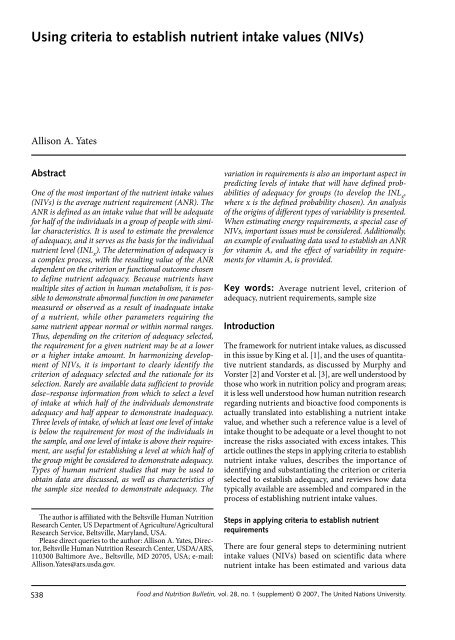Implementing food-based dietary guidelines for - United Nations ...
Implementing food-based dietary guidelines for - United Nations ...
Implementing food-based dietary guidelines for - United Nations ...
You also want an ePaper? Increase the reach of your titles
YUMPU automatically turns print PDFs into web optimized ePapers that Google loves.
Using criteria to establish nutrient intake values (NIVs)<br />
Allison A. Yates<br />
Abstract<br />
One of the most important of the nutrient intake values<br />
(NIVs) is the average nutrient requirement (ANR). The<br />
ANR is defined as an intake value that will be adequate<br />
<strong>for</strong> half of the individuals in a group of people with similar<br />
characteristics. It is used to estimate the prevalence<br />
of adequacy, and it serves as the basis <strong>for</strong> the individual<br />
nutrient level (INL x ). The determination of adequacy is<br />
a complex process, with the resulting value of the ANR<br />
dependent on the criterion or functional outcome chosen<br />
to define nutrient adequacy. Because nutrients have<br />
multiple sites of action in human metabolism, it is possible<br />
to demonstrate abnormal function in one parameter<br />
measured or observed as a result of inadequate intake<br />
of a nutrient, while other parameters requiring the<br />
same nutrient appear normal or within normal ranges.<br />
Thus, depending on the criterion of adequacy selected,<br />
the requirement <strong>for</strong> a given nutrient may be at a lower<br />
or a higher intake amount. In harmonizing development<br />
of NIVs, it is important to clearly identify the<br />
criterion of adequacy selected and the rationale <strong>for</strong> its<br />
selection. Rarely are available data sufficient to provide<br />
dose–response in<strong>for</strong>mation from which to select a level<br />
of intake at which half of the individuals demonstrate<br />
adequacy and half appear to demonstrate inadequacy.<br />
Three levels of intake, of which at least one level of intake<br />
is below the requirement <strong>for</strong> most of the individuals in<br />
the sample, and one level of intake is above their requirement,<br />
are useful <strong>for</strong> establishing a level at which half of<br />
the group might be considered to demonstrate adequacy.<br />
Types of human nutrient studies that may be used to<br />
obtain data are discussed, as well as characteristics of<br />
the sample size needed to demonstrate adequacy. The<br />
The author is affiliated with the Beltsville Human Nutrition<br />
Research Center, US Department of Agriculture/Agricultural<br />
Research Service, Beltsville, Maryland, USA.<br />
Please direct queries to the author: Allison A. Yates, Director,<br />
Beltsville Human Nutrition Research Center, USDA/ARS,<br />
110300 Baltimore Ave., Beltsville, MD 20705, USA; e-mail:<br />
Allison.Yates@ars.usda.gov.<br />
S38<br />
variation in requirements is also an important aspect in<br />
predicting levels of intake that will have defined probabilities<br />
of adequacy <strong>for</strong> groups (to develop the INL x ,<br />
where x is the defined probability chosen). An analysis<br />
of the origins of different types of variability is presented.<br />
When estimating energy requirements, a special case of<br />
NIVs, important issues must be considered. Additionally,<br />
an example of evaluating data used to establish an ANR<br />
<strong>for</strong> vitamin A, and the effect of variability in requirements<br />
<strong>for</strong> vitamin A, is provided.<br />
Key words: Average nutrient level, criterion of<br />
adequacy, nutrient requirements, sample size<br />
Introduction<br />
The framework <strong>for</strong> nutrient intake values, as discussed<br />
in this issue by King et al. [1], and the uses of quantitative<br />
nutrient standards, as discussed by Murphy and<br />
Vorster [2] and Vorster et al. [3], are well understood by<br />
those who work in nutrition policy and program areas;<br />
it is less well understood how human nutrition research<br />
regarding nutrients and bioactive <strong>food</strong> components is<br />
actually translated into establishing a nutrient intake<br />
value, and whether such a reference value is a level of<br />
intake thought to be adequate or a level thought to not<br />
increase the risks associated with excess intakes. This<br />
article outlines the steps in applying criteria to establish<br />
nutrient intake values, describes the importance of<br />
identifying and substantiating the criterion or criteria<br />
selected to establish adequacy, and reviews how data<br />
typically available are assembled and compared in the<br />
process of establishing nutrient intake values.<br />
Steps in applying criteria to establish nutrient<br />
requirements<br />
There are four general steps to determining nutrient<br />
intake values (NIVs) <strong>based</strong> on scientific data where<br />
nutrient intake has been estimated and various data<br />
Food and Nutrition Bulletin, vol. 28, no. 1 (supplement) © 2007, The <strong>United</strong> <strong>Nations</strong> University.




